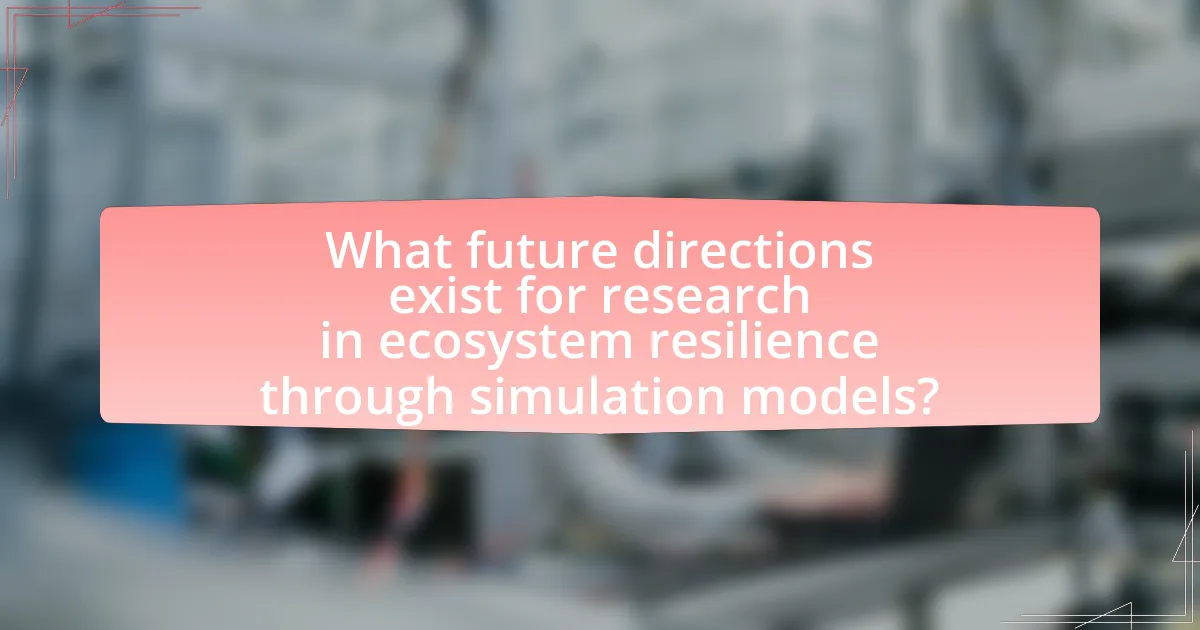Evaluating the resilience of ecosystems through simulation models involves using computational frameworks to assess how ecosystems respond to disturbances and stressors. This article outlines the significance of simulation models in understanding ecosystem resilience, detailing their key features, methodologies, and applications in real-world scenarios. It discusses the factors contributing to ecosystem resilience, the implications of model findings for ecosystem management, and the challenges researchers face in utilizing these models. Additionally, the article highlights future directions for research, including advancements in technology and interdisciplinary approaches that can enhance model effectiveness.

What is Evaluating the Resilience of Ecosystems through Simulation Models?
Evaluating the resilience of ecosystems through simulation models involves assessing how ecosystems respond to disturbances and stressors using computational frameworks. These models simulate various scenarios, allowing researchers to predict ecosystem behavior under different conditions, such as climate change or habitat loss. For instance, studies have shown that simulation models can effectively illustrate the recovery trajectories of ecosystems after disturbances, providing insights into their adaptive capacity and stability. This approach is validated by research indicating that simulation models can accurately reflect real-world ecological dynamics, thereby enhancing our understanding of ecosystem resilience.
How do simulation models contribute to understanding ecosystem resilience?
Simulation models enhance the understanding of ecosystem resilience by allowing researchers to simulate various environmental scenarios and assess the responses of ecosystems to disturbances. These models can incorporate complex interactions among species, abiotic factors, and human influences, providing insights into how ecosystems recover from stressors such as climate change, pollution, or habitat loss. For instance, studies have shown that simulation models can predict the resilience of coral reefs to bleaching events by analyzing factors like temperature thresholds and species diversity. This predictive capability is crucial for developing effective conservation strategies and managing ecosystems sustainably.
What are the key features of simulation models used in ecological studies?
Simulation models used in ecological studies are characterized by their ability to replicate complex ecological interactions and processes. These models typically incorporate key features such as dynamic system representation, which allows for the simulation of changes over time; spatial heterogeneity, enabling the modeling of variations across different geographical areas; and feedback mechanisms that illustrate how changes in one component of the ecosystem can affect others. Additionally, they often utilize stochastic elements to account for randomness and uncertainty in ecological processes, enhancing their realism. Empirical validation is also a critical feature, as these models are frequently calibrated and tested against real-world data to ensure their accuracy and reliability in predicting ecological outcomes.
How do these models simulate ecological interactions and processes?
Simulation models simulate ecological interactions and processes by using mathematical representations of biological and environmental systems to predict outcomes based on various scenarios. These models incorporate factors such as species interactions, nutrient cycling, and energy flow, allowing researchers to analyze how ecosystems respond to changes, such as climate shifts or human impacts. For instance, the Ecopath with Ecosim model integrates trophic interactions and biomass dynamics, providing insights into ecosystem resilience and stability under different management strategies. This approach enables the evaluation of potential ecological outcomes, supporting informed decision-making in conservation and resource management.
Why is resilience important in ecosystems?
Resilience is important in ecosystems because it enables them to absorb disturbances and maintain essential functions and services. Ecosystems with high resilience can recover from environmental changes, such as climate fluctuations or human impacts, ensuring biodiversity and stability. For instance, coral reefs can withstand bleaching events better when they exhibit resilience, allowing them to recover and continue providing habitat for marine life. This capacity for recovery is crucial for sustaining ecosystem health and supporting human livelihoods that depend on these natural systems.
What factors contribute to the resilience of an ecosystem?
The resilience of an ecosystem is primarily influenced by biodiversity, ecological interactions, and environmental variability. Biodiversity enhances resilience by providing a variety of species that can fulfill different ecological roles, which helps maintain ecosystem functions during disturbances. For instance, ecosystems with higher species diversity are better able to recover from events like droughts or floods, as demonstrated by studies showing that diverse plant communities can recover more quickly after disturbances compared to monocultures. Ecological interactions, such as predator-prey relationships and mutualisms, also contribute to resilience by stabilizing populations and promoting ecosystem health. Additionally, environmental variability, including climate fluctuations and nutrient availability, can shape resilience by influencing species composition and ecosystem dynamics. Research indicates that ecosystems exposed to a range of environmental conditions tend to develop adaptive strategies that enhance their ability to withstand and recover from stressors.
How does resilience affect ecosystem services and biodiversity?
Resilience significantly enhances ecosystem services and biodiversity by enabling ecosystems to recover from disturbances and maintain functionality. Resilient ecosystems can better withstand environmental changes, such as climate fluctuations or human impacts, which in turn supports the provision of essential services like clean water, pollination, and carbon sequestration. For instance, studies have shown that diverse ecosystems with high resilience can recover more quickly from events like wildfires or floods, thereby sustaining their biodiversity and the services they provide. Research indicates that ecosystems with greater biodiversity tend to exhibit higher resilience, as species interactions and genetic diversity contribute to adaptive capacity, ultimately reinforcing the stability and productivity of these systems.
What methodologies are used in evaluating ecosystem resilience?
Methodologies used in evaluating ecosystem resilience include simulation modeling, empirical assessments, and remote sensing techniques. Simulation modeling, such as agent-based models and system dynamics, allows researchers to predict ecosystem responses to various stressors by simulating interactions within the ecosystem. Empirical assessments involve field studies and experiments that measure resilience indicators, such as biodiversity and productivity, under different environmental conditions. Remote sensing techniques utilize satellite imagery and aerial data to monitor changes in land cover and ecosystem health over time, providing valuable insights into resilience patterns. These methodologies collectively enhance understanding of ecosystem resilience and inform management strategies.
What types of simulation models are commonly employed?
Commonly employed types of simulation models include agent-based models, system dynamics models, and discrete-event simulation models. Agent-based models simulate the interactions of individual agents to assess their effects on the system as a whole, which is crucial for understanding ecosystem dynamics. System dynamics models focus on the feedback loops and time delays within complex systems, allowing researchers to analyze how changes in one part of the ecosystem can impact others over time. Discrete-event simulation models represent systems as a sequence of events that occur at specific points in time, making them useful for studying processes that change at distinct intervals. These models are widely used in ecological research to evaluate resilience by simulating various scenarios and their potential impacts on ecosystems.
How do researchers validate the accuracy of these models?
Researchers validate the accuracy of simulation models used to evaluate ecosystem resilience through a combination of empirical data comparison, sensitivity analysis, and cross-validation techniques. Empirical data comparison involves assessing model outputs against observed data from real ecosystems to ensure that the model accurately reflects ecological dynamics. Sensitivity analysis examines how variations in model parameters affect outcomes, helping to identify critical factors influencing model behavior. Cross-validation techniques involve partitioning data into subsets to train and test the model, ensuring that it performs reliably across different scenarios. These methods collectively enhance the credibility of the models, as demonstrated in studies such as “Modeling Ecosystem Resilience: A Review” published in Ecological Modelling, which emphasizes the importance of rigorous validation processes in ecological modeling.
How can simulation models be applied in real-world scenarios?
Simulation models can be applied in real-world scenarios to assess and predict the behavior of ecosystems under various conditions. These models enable researchers to simulate environmental changes, such as climate variations or human impacts, and evaluate how these factors affect ecosystem resilience. For instance, a study published in “Ecological Modelling” by Grimm et al. (2010) demonstrates how simulation models can forecast species interactions and community dynamics, providing insights into ecosystem stability and recovery processes. By utilizing these models, decision-makers can develop effective conservation strategies and manage natural resources more sustainably.
What challenges do researchers face when using simulation models?
Researchers face several challenges when using simulation models, including data limitations, model complexity, and validation issues. Data limitations arise from the difficulty in obtaining accurate and comprehensive datasets necessary for effective modeling. Model complexity can lead to difficulties in understanding and interpreting results, as intricate models may incorporate numerous variables and interactions that complicate analysis. Validation issues stem from the challenge of confirming that the simulation accurately represents real-world systems, which is crucial for ensuring the reliability of the model’s predictions. These challenges can hinder the effectiveness of simulation models in evaluating ecosystem resilience.

What are the implications of findings from simulation models on ecosystem management?
Findings from simulation models significantly influence ecosystem management by providing data-driven insights into ecosystem dynamics and resilience. These models allow managers to predict the outcomes of various management strategies under different environmental scenarios, thereby facilitating informed decision-making. For instance, simulation models can reveal how changes in land use or climate conditions may affect species populations and habitat quality, enabling proactive measures to mitigate negative impacts. Research has shown that using simulation models can enhance the effectiveness of conservation efforts, as evidenced by studies demonstrating improved biodiversity outcomes when management strategies are guided by model predictions.
How can simulation models inform conservation strategies?
Simulation models can inform conservation strategies by providing predictive insights into ecosystem dynamics and species interactions. These models allow researchers to simulate various environmental scenarios, assess potential impacts of human activities, and evaluate the effectiveness of different conservation interventions. For instance, studies have shown that models like the Ecological Modeling Framework can predict the outcomes of habitat restoration efforts, enabling conservationists to prioritize actions that enhance biodiversity and ecosystem resilience. By integrating data on species behavior, climate variables, and habitat conditions, simulation models serve as valuable tools for decision-making in conservation planning.
What role do simulation models play in predicting ecosystem responses to climate change?
Simulation models are essential tools for predicting ecosystem responses to climate change by simulating complex interactions within ecosystems under varying climate scenarios. These models integrate data on species interactions, climate variables, and ecological processes to forecast potential changes in biodiversity, productivity, and ecosystem services. For instance, the use of dynamic vegetation models has demonstrated how shifts in temperature and precipitation patterns can alter species distributions and ecosystem functions, as evidenced by studies like the one conducted by Scheiter and Higgins (2009) in “The role of vegetation dynamics in the response of ecosystems to climate change.” Such models provide critical insights that inform conservation strategies and policy decisions aimed at enhancing ecosystem resilience in the face of climate change.
How can stakeholders utilize model outputs for decision-making?
Stakeholders can utilize model outputs for decision-making by analyzing the data to inform resource allocation, risk assessment, and strategic planning. For instance, simulation models that evaluate ecosystem resilience provide insights into potential impacts of environmental changes, enabling stakeholders to prioritize conservation efforts and manage resources effectively. Research indicates that stakeholders who incorporate model outputs into their decision-making processes can enhance adaptive management strategies, as evidenced by case studies demonstrating improved outcomes in biodiversity conservation and ecosystem services management.
What are the limitations of simulation models in evaluating ecosystem resilience?
Simulation models have several limitations in evaluating ecosystem resilience, primarily due to their reliance on simplifications and assumptions that may not accurately reflect real-world complexities. These models often struggle to incorporate the full range of ecological interactions, such as species diversity and interdependencies, which are crucial for understanding resilience. Additionally, simulation models can be sensitive to initial conditions and parameter choices, leading to variability in outcomes that may not be representative of actual ecosystem behavior. Furthermore, the lack of empirical validation for some models can result in uncertainty regarding their predictive capabilities. For instance, a study by Carpenter et al. (2011) highlights that many models fail to account for nonlinear responses in ecosystems, which can lead to misleading conclusions about resilience.
How do uncertainties in data affect model predictions?
Uncertainties in data significantly impact model predictions by introducing variability and potential inaccuracies in the outcomes. When data used in simulation models is uncertain, it can lead to erroneous parameter estimates, which in turn affect the model’s ability to accurately represent ecosystem dynamics. For instance, a study by Beven and Freer (2001) highlights that uncertainties in input data can propagate through the model, resulting in a range of possible predictions rather than a single deterministic outcome. This variability can mislead decision-making processes regarding ecosystem management and resilience evaluation, as models may suggest different scenarios based on the level of uncertainty present in the data.
What are the common pitfalls in interpreting simulation results?
Common pitfalls in interpreting simulation results include overgeneralization, misinterpretation of model assumptions, and neglecting uncertainty. Overgeneralization occurs when results from a specific simulation are applied to broader contexts without considering the unique variables involved. Misinterpretation of model assumptions can lead to incorrect conclusions, as simulations are based on specific parameters that may not reflect real-world conditions. Neglecting uncertainty, often represented by confidence intervals or sensitivity analyses, can result in overconfidence in the results, ignoring the variability inherent in ecological systems. These pitfalls can significantly distort the understanding of ecosystem resilience as derived from simulation models.

What future directions exist for research in ecosystem resilience through simulation models?
Future directions for research in ecosystem resilience through simulation models include enhancing model complexity to incorporate more variables, such as climate change impacts and species interactions. Researchers aim to develop multi-scale models that integrate local and global data, allowing for better predictions of ecosystem responses to disturbances. Additionally, there is a push for incorporating machine learning techniques to improve model accuracy and adaptability. Studies like “A framework for assessing ecosystem resilience using simulation models” by Walker et al. (2019) highlight the importance of these advancements in understanding ecosystem dynamics.
How can advancements in technology enhance simulation models?
Advancements in technology can enhance simulation models by improving their accuracy, efficiency, and scalability. For instance, the integration of artificial intelligence and machine learning algorithms allows for more sophisticated data analysis and predictive modeling, which can lead to better understanding of ecosystem dynamics. Additionally, high-performance computing enables the processing of large datasets, facilitating complex simulations that were previously infeasible. Research has shown that using advanced computational techniques can increase the resolution of ecological models, allowing for more detailed and realistic representations of ecosystems (e.g., the work by Levin et al. in “Ecological Modelling” demonstrates enhanced predictive capabilities through these technologies).
What emerging trends are shaping the future of ecological modeling?
Emerging trends shaping the future of ecological modeling include the integration of machine learning techniques, the use of big data analytics, and the incorporation of participatory modeling approaches. Machine learning enhances predictive capabilities by analyzing complex ecological data patterns, as evidenced by studies showing improved accuracy in species distribution models. Big data analytics allows for the processing of vast datasets from remote sensing and citizen science, facilitating real-time ecological assessments. Participatory modeling engages stakeholders in the modeling process, ensuring that local knowledge and values are incorporated, which has been shown to improve the relevance and acceptance of ecological models in decision-making contexts.
How can interdisciplinary approaches improve model effectiveness?
Interdisciplinary approaches can improve model effectiveness by integrating diverse perspectives and methodologies, which enhances the accuracy and applicability of simulation models in evaluating ecosystem resilience. For instance, combining insights from ecology, economics, and social sciences allows for a more comprehensive understanding of complex interactions within ecosystems. Research has shown that models incorporating ecological data alongside socio-economic factors yield more reliable predictions of ecosystem responses to stressors, as evidenced by the work of Levin et al. (2017) in “Ecosystem Services and Human Well-Being: A Multiscale Approach” published in the journal Ecosystem Services. This integration leads to models that are not only scientifically robust but also relevant to policy-making and resource management, ultimately improving their effectiveness in real-world applications.
What best practices should researchers follow when using simulation models?
Researchers should follow best practices such as clearly defining the objectives of the simulation, validating the model against real-world data, and ensuring transparency in the modeling process. Clearly defined objectives guide the development and application of the simulation, ensuring that it addresses specific research questions. Validation against empirical data enhances the model’s credibility, as demonstrated by studies that show models with high validation scores yield more reliable predictions. Transparency in the modeling process, including documentation of assumptions and methodologies, allows for reproducibility and peer review, which are essential for scientific integrity.


